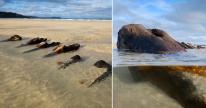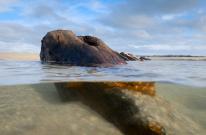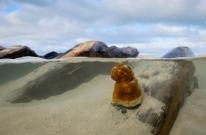Experts are unsure which ship these remains are from (Picture: Cornwall Live/BPM Media)
A host of mysterious Victorian shipwrecks have re-emerged off the coast of Cornwall for the first time in decades.
Thanks to a combination of winter storms and very low tides, the wooden structures – believed to date back to the 1800s or possibly even earlier – have again been spotted near St Ives, where many locals have never seen them before.
Their exact origin is unknown, but they are believed to be the remains of either the French brigantine Providence, which was wrecked during a storm in October 1865, or the German brigantine SV Albert Wilhelm, which hit a reef and sank in October 1886.
Residents near the site of the shipwreck at Porth Kidney Sands say they cannot remember the last time these particular wrecks were visible.
One of the earliest recorded shipwrecks on the beach is that of a Spanish ship carrying cloth in 1514, when Porth Kidney Sands was known as Polkemyas.
There are also accounts of the cargo ship Recovery being wrecked in the area during a storm in November 1780, as well as the Severn in 1859.
But experts nonetheless believe the most likely origins of the wrecks are the French brigantine Providence and SV Albert Wilhelm.
The Albert Wilhelm was eventually broken up and taken away, with only part of the hull left in the sands.
Many locals cannot remember ever seeing the wrecks at Porth Kidney Sands near St Ives (Picture: Cornwall Live/BPM Media)
New pictures show wooden structures that are barely intact visible on the beach.
Elsewhere, there are other remains of ships nearby that are more familiar to locals, including the jagged fragments of the steam collier Bessie, one mile away at Carbis Bay.
That was wrecked along with various other ships during a raging storm named Cintra, in November 1893.
Those wrecks also occasionally reveal themselves after winter storms when there are low tides.
The French brigantine Providence or the German brigantine Albert Wilhelm are believed to be the most likely contenders (Picture: Cornwall Live/BPM Media)
As the Cintra Gale broke up, another steamer with a cargo of coal, the 345 tonne Vulture, was wrecked less than 100 metres down the beach.
A third iron steamship, named Bessie, which had been sheltering from the storm was driven onto the beach next to the Vulture.
A short distance away, in St Ives, the cargo ship Rosedale was driven sideways onto Porthminster beach, where she later broke in two and was wrecked.
Another casualty of the Cintra Gale was the 1,593 tonne Hampshire, which was abandoned off the coast of Gwithian after it started sinking.
The wooden structures do not reveal much about their origins (Picture: Cornwall Live/BPM Media)
On 19 November 1893, local farmer James Stevens wrote in his diary: ‘A man came ashore this morning at Gurnard’s Head, being the only one that is known to be saved of a steamer’s crew of 25 which went down about 3 miles off.
‘This has been the hardest and longest gale that the oldest ever remembered. Four steamers wrecked at St. Ives. Several men were saved by the Rocket Apparatus and some were drowned.
‘The fury of the gale was felt in Devon and Cornwall doing an immense lot of damage on sea and land.
‘The Cornishman newspaper estimated the loss of life on sea and land to be 1,000 people. The wind was so hard that a train coming to St. Ives was unable to come against it and was brought to a standstill.
‘The wind veered from one point to another blowing hard from NNE.’
The remains of the Bessie, at the eastern end of Carbis Bay, were last uncovered at the beginning of 2020 following Storm Ciara. Fragments of both the Vulture and Cintra were exposed during big low tides in 2019 and 2017.
In comparison to those well-documented stories from Carbis Bay, the new wooden timbers which have appeared on Porth Kidney Sands remain more mysterious.















